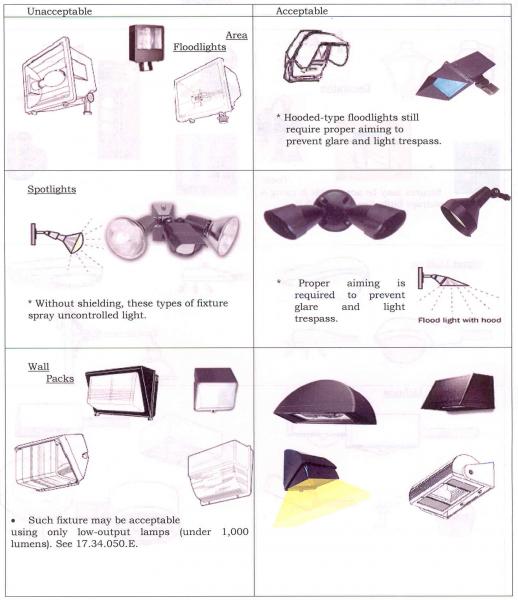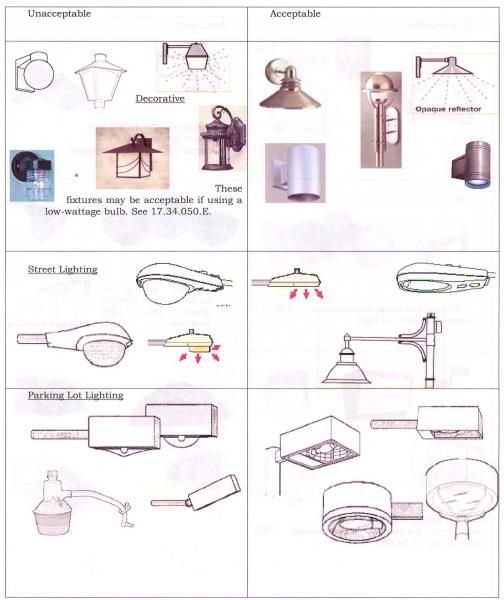Chapter 23- Dark Sky Regulations
23.010 Purpose.
23.020 Definitions.
23.030 Applicability.
23.040 Exemptions.
23.050 General Requirements.
23.060 Outdoor Lighting Plans.
23.070 Prohibitions.
23.080 Signs.
23.090 Outdoor Performance, Sport and Recreation Facilities.
23.100 Energy Conservation Measures.
23.110 Violations and Penalties.
23.120 Repeals.
23.130 Figures and Diagrams.
23.010 Purpose.
- The purpose of this chapter is to provide rules and regulations for outdoor lighting within Mono County except north of Mountain Gate in order to accomplish the following:
- To promote a safe and pleasant nighttime environment for residents and visitors;
- To protect and improve safe travel for all modes of transportation;
- To prevent nuisances caused by unnecessary light intensity, direct glare, and light trespass;
- To protect the ability to view the night sky by restricting unnecessary upward projection of light;
- Through new building permits phase out existing nonconforming fixtures that violate this chapter; and
- To promote lighting practices and systems to conserve energy.
- This chapter shall be known and may be cited as the Mono County Outdoor Lighting Ordinance.
- The figures incorporated in this chapter or shown on informational sheets produced by Mono County are provided as guidelines for the public and staff to use in meeting the intent of this chapter. The figures serve only as examples. Mono County does not endorse or discriminate against any manufacturer or company that may be shown, portrayed, or mentioned as examples.
23.020 Definitions. Unless specifically defined below, the words and phrases used in this chapter shall be interpreted to give the meaning they have in common usage, and to give this chapter its most reasonable application.
“Fixture” means a complete lighting unit including the lamp and parts designed to distribute the light, position and protect the lamp, and connect the lamp to a power source. Also referred to as a “luminaire.”
“Footcandle (fc)” means a unit of measurement for the total amount of light cast on a surface (illuminance). One footcandle is equivalent to the illuminance produced by a source of one candle at a distance of one foot.
“Full Cutoff Fixture” means a lighting fixture designed such that no light, either directly from the bulb or indirectly from the fixture, is emitted at or above a horizontal plane running through the lowest point on the fixture.
“Glare” means direct and unshielded light striking the eye to result in visual discomfort and reduced visual performance.
“Lamp” means an artificial light source installed in the socket portion of the fixture, to be distinguished from the whole assembly. Commonly referred to as a “bulb.”
“Light Pollution” means any adverse effect of artificial light sources including, but not limited to, discomfort to the eye or diminished vision due to glare, light trespass, uncontrolled up-lighting, uncomfortable distraction to the eye, or any artificial light that diminishes the ability to view the night sky.
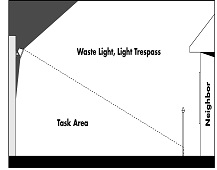
Light trespass from uncontrolled source
Controlled source and good aiming prevents light trespass
“Light Trespass” means light falling where it is not wanted or needed, generally light from one property that shines onto another property or the public right of way.
“Lumen” means the unit used to quantify the amount of light energy produced by a lamp. For example, a 40-watt incandescent lamp produces approximately 400 lumens, while a 35-watt high-pressure sodium lamp produces about 2,300 lumens.
“Outdoor Lighting Fixture” means any temporary or permanent lighting fixture that is installed, located, or used in such a manner to provide illumination of objects or activities outside. Outdoor lighting fixtures include all fixtures mounted to the exterior of a structure, poles, bollards, or other freestanding structures, or placed so as to provide direct illumination on any exterior area or activity.
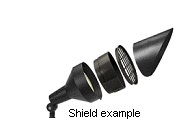
“Shielding” means a barrier around or within a fixture that helps conceal the lamp and control light distribution. A fixture that is “fully shielded” incorporates a solid barrier, emits no light rays above the horizontal plane and effectively obscures visibility of the lamp. A fixture that is “partially shielded” may allow some light to pass through a semi-translucent barrier, and/or may allow visibility of the lamp from certain perspectives.
“Temporary Lighting” means lighting that is intended to be used for a special event for up to seven days.
23.030 Applicability.
- New Outdoor Lighting. All outdoor lighting fixtures installed after the effective date of this chapter shall conform to the requirements established by this chapter.
- Existing Outdoor Lighting. All existing outdoor lighting fixtures installed prior to the effective date of this chapter shall be addressed as follows:
- To address nuisances caused by improperly installed, unshielded, or misdirected fixtures, it is recommended that all existing outdoor lighting fixtures be adjusted or modified to the extent practical to reduce or eliminate glare, light trespass, and light pollution.
- All existing outdoor lighting fixtures located on a property that is part of an application for Design Review approval; a Conditional Use Permit; subdivision approval; or, a building permit for any new structure, or new or modified exterior light fixtures, or any addition(s) of gross floor area, seating capacity, or parking spaces (either with a single addition or cumulative additions), shall meet the requirements of this chapter for the entire property. Such applications are required to include an outdoor lighting plan pursuant to section 23.060. Conformity shall occur prior to final inspection, final plat recordation, or business license issuance, when applicable.
23.040 Exemptions.
- The following are exempt from the provisions of this chapter:
- Seasonal displays using multiple low-wattage bulbs (approximately 15 lumens or less), provided that they do not constitute a fire hazard, create a nuisance, and are maintained in a safe and attractive condition.
- Vehicular lights and all temporary emergency lighting needed by the law enforcement and Fire Protection District, or other emergency services.
- All temporary lighting used for the construction or repair of roadways, utilities, and other public infrastructure.
- All lighting required by state or federal regulatory agencies.
- Illuminated address at no more than 15 lumens.
- The Community Development director may authorize minor deviations when proposed outdoor lighting does not conflict with the purposes of this chapter. An application for such a deviation must be made in writing and include an outdoor lighting plan pursuant to sections 23.050 G and 23.06O. Temporary lighting for special events shall be reviewed in this manner.
23.050 General Requirements.
The following general standards apply to all non-exempt outdoor lighting fixtures:
- Nuisance prevention. All outdoor lighting fixtures shall be designed, located, installed, aimed downward or toward structures, retrofitted if necessary, and maintained in order to prevent glare, light trespass, and light pollution.
- Maintenance. Fixtures and lighting systems shall be in good working order and maintained in a manner that serves the original design intent of the system.
- Lighting Levels. Outdoor lighting installations shall be designed to avoid harsh contrasts in lighting levels between the project site and the adjacent properties. The Mono County Planning Commission may, by resolution, adopt standards for maximum or minimum lighting levels for various land use areas and for public streets, sidewalks, or trails, as developed by the Community Development and Public Works departments.
- Lamp Types. Metal halide or high-pressure sodium lamps are preferred for all new commercial and industrial area lighting (parking lot and yard lights) and street lighting due to good color rendering and good energy efficiency, and LEDs are preferred for energy efficiency. Low-pressure sodium lamps and mercury vapor lamps are not permitted. LEDs or compact fluorescent lamps are preferred for residential lighting.
- Fixture Types. All new outdoor lighting shall use full cutoff luminaires with the light source downcast and fully shielded with no light emitted above the horizontal plane, with the following exceptions:
- Fixtures that have a maximum output of 100 lumens (equivalent to one 10-watt incandescent bulb) or less, regardless of the number of bulbs, may be left unshielded provided the bulb surfaces are obscured from off-site visibility with a semi-translucent or frosted glass that has an opaque top to prevent the light from shining directly up. However, partial or full shielding is preferred to control light output in all situations.
- Fixtures that have a maximum output of 600 lumens (equivalent to one 40-watt incandescent bulb) or less shall be partially or totally shielded using a solid or semi-translucent barrier, provided that the lamp is not visible from off site, no direct glare is produced, and the fixture has an opaque top to keep light from shining directly up; e.g., a low output-style wall pack.
- Floodlights that do not meet the definition of “full cutoff” may be used if permanently directed downward, if no light is projected above the horizontal plane, and if and fitted with external shielding to prevent glare and off-site light trespass. Unshielded floodlights are prohibited.
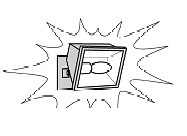
Glare from unshielded floodlight
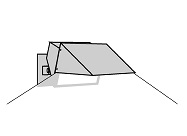
Shielding prevents glare
- Accent Lighting. Residential accent lighting shall be limited. LED-type accent lighting is preferred. Commercial accent lighting may be permitted in conjunction with a use permit. Limited architectural features may be illuminated by uplighting, provided that the light is effectively contained by the structure, the lamps are low intensity to produce a subtle lighting effect, and no glare or light trespass is produced. For statues, public art, or other objects of interest that cannot be illuminated with down-lighting, upward lighting may be used only in the form of one narrow-cone spotlight that confines the illumination to the object of interest.
- The provisions of this chapter are not intended to prevent the use of any design, material, or method of installation or operation not specifically prescribed herein, provided that the Community Development director has approved any such alternative. An alternative proposal may be approved if it provides at least approximate equivalence to the applicable specific requirements of this chapter, or if it is otherwise satisfactory and complies with the intent of this chapter.
- Mono County reserves the right to further restrict outdoor lighting including, but not limited to, pole height and level of illumination, when it is deemed in the public interest consistent with the purpose of this chapter.
23.060 Outdoor Lighting Plans.
- An outdoor lighting plan shall be submitted in conjunction with an application for design review approval; a Conditional Use Permit; subdivision approval; or, a building permit for any new structure, or new or modified exterior light fixtures, or any addition(s) of gross floor area, seating capacity, or parking spaces (either with a single addition or cumulative additions). An outdoor lighting plan is required for all new outdoor lighting installations on commercial (includes multifamily residential project of four or more units), industrial, public and institutional properties. The Community Development director may request outdoor lighting plans from applicants for other types of projects due to project location, size, or proposed use, as necessary. An outdoor lighting plan shall include at least the following:
- Manufacturer specification sheets, cut-sheets, or other manufacturer-provided information for all proposed outdoor lighting fixtures to show fixture diagrams and light output levels;
- The proposed location, mounting height, and aiming point of all outdoor lighting fixtures (a site plan is preferred); and
- If building elevations are proposed for illumination, drawings for all relevant building elevations showing the fixtures, the portions of the elevations to be illuminated, the illuminance level of the elevations, and the aiming point for any remote light fixture.
- If needed to review the proposed outdoor lighting fixture installation, the Community Development director may require additional information following the initial outdoor lighting plan submittal, including but not limited to a written narrative to demonstrate the objectives of the lighting, Photometric data, Color Rendering Index (CRI) of all lamps and other descriptive information on the fixtures, computer-generated photometric grid showing footcandle readings every 10 feet within the property or site and 10 feet beyond the property lines (an iso-footcandle contour line-style plan may be acceptable), and/or landscaping information to describe potential screening.

Example of a narrow-cone spotlight
- The Community Development director may approve, deny, or require modifications to any outdoor lighting plan in order to meet the purpose of this chapter.
23.070 Prohibitions.
- The installation of any new fixture not in conformance to this chapter is prohibited.
- No outdoor lighting fixtures shall be installed, aimed, or directed to produce light that spills over into neighboring properties or the public right of way. Light trespass is prohibited.
- No outdoor lighting fixture may be installed or maintained in such a manner to cause glare visible from off site.
- No outdoor lighting fixture may be operated in such a manner as to constitute a hazard or danger to persons, or to safe vehicular travel.
- Blinking, flashing, moving, revolving, scintillating, flickering, changing-intensity, and changing-color lights and internally illuminated signs are prohibited.
- The installation of new mercury vapor and/or low-pressure sodium lamps is prohibited.
- Search lights, laser source lights, or any similar high-intensity light is prohibited except in emergencies by police and fire personnel or at their direction, or for approved temporary lighting.
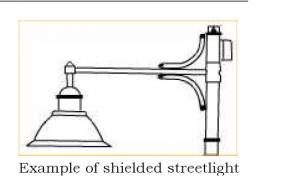
- Streetlights shall be down directed with complete horizontal shielding of the reflective surface and no higher than 17 feet from the bottom of the shielded fixture surface with a maximum 150-watt lamp. Greater height may be granted by the Community Development director for safety or adopted minimum highway standards.
23.080 Signs.
All outdoor lighting for commercial signs installed and maintained pursuant to Chapter 07 shall conform to the provisions of this chapter. Light bulbs or lighting tubes used for sign illumination shall not be readily visible from the vehicular travel lanes, adjacent public rights of way, or adjoining properties. The intensity of sign lighting shall not exceed that necessary to illuminate and make legible a sign from the approved location of view, such as pedestrian walkway, adjacent travel way or closest County street.
23.090 Outdoor Performance, Sport and Recreation Facilities.
- Where playing fields or other special activity areas are to be illuminated, lighting fixtures shall be mounted, aimed, and shielded so that their beams fall within the primary playing area and immediate surroundings, and so that no significant off-site light trespass is produced.
- The main lighting shall be turned off as soon as possible following the end of an event. Where feasible, a low-level lighting system shall be used to facilitate patrons leaving the facility, cleanup, nighttime maintenance, and other closing activities.
23.100 Energy Conservation Measures.
Incorrect installations, poor choice of fixtures, and over-lighting can result in unnecessarily high energy costs. The following recommendations are intended to encourage the efficient use of energy for lighting purposes:
- All non-essential outdoor commercial and residential lighting shall be turned off after business hours and/or when not in use. Limited accent lighting and safety lighting as approved by the Community Development director may remain illuminated after business hours.
- Where practical, outdoor lighting installations are encouraged to include timers, dimmers, or photocell controllers that turn lights off during daylight hours to reduce overall energy consumption and eliminate unnecessary lighting.
- When selecting new outdoor lighting, the full cost of operation over the life of the fixture(s) should be considered. Substantial annual energy savings may be realized by using quality efficient fixtures.
- Indiscriminate and excessive lighting shall be avoided. Light should be directed only to where it is needed with appropriate intensity.
23.110 Violations and Penalties.
It shall be unlawful to install or operate any outdoor lighting fixture in violation of this chapter. Any person violating any provisions of this chapter may be subject to the provisions of Mono County Code section 1.04.060. In addition, any outdoor lighting fixture erected or maintained contrary to the provisions of this chapter may be declared to be a public nuisance subject to the procedures set forth in County Code Chapter 07.20. Such remedies are in addition to and may be sought or imposed concurrently with any other remedy provided by law, regulation or ordinance.
23.120 Figures and Diagrams.
The following figures illustrate examples of acceptable and unacceptable types of outdoor lighting fixtures. Note that even those types of fixtures shown as “acceptable” must be installed and aimed properly to comply with this chapter.
23.130 Repeals.
This chapter supersedes and takes precedence over any other code sections that are inconsistent with these regulations.
FIGURE 14: EXAMPLES OF LIGHTING FIXTURES
